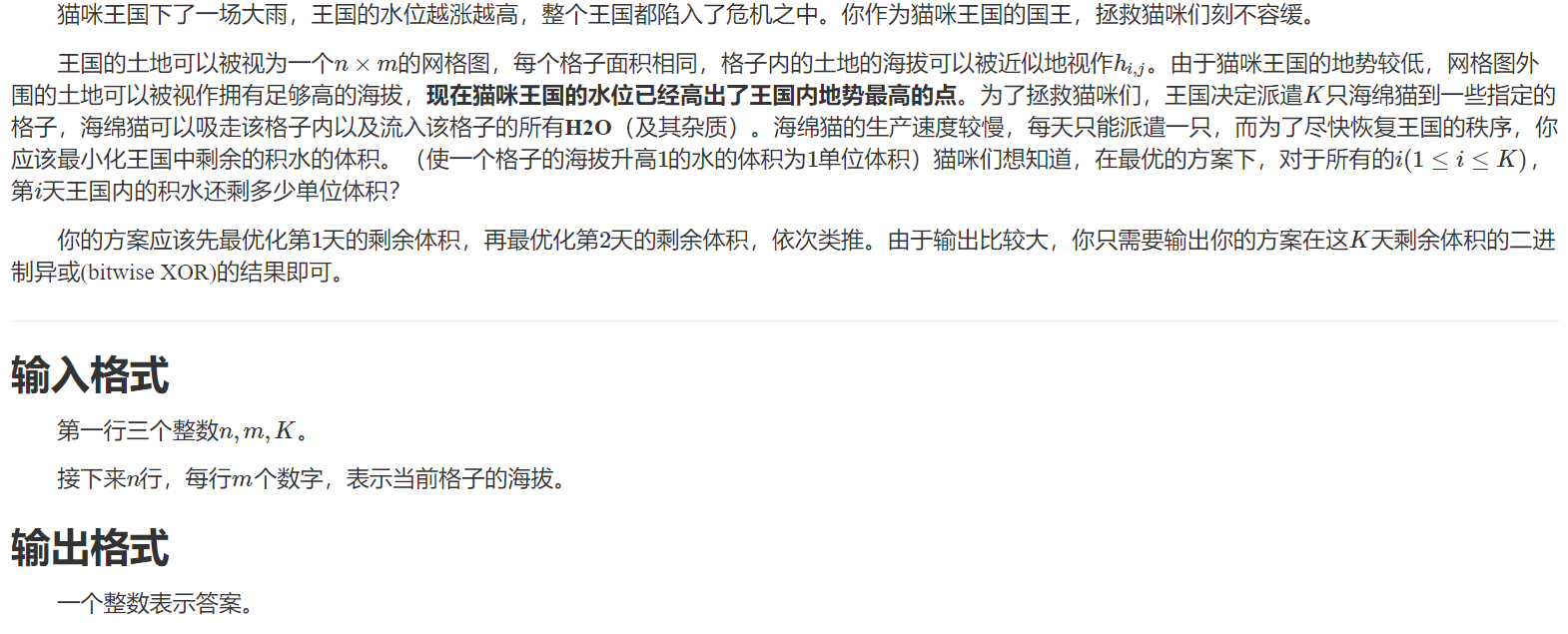LINK:H2O


这场比赛打的稀烂 爆蛋.
只会暴力.感觉暴力细节比较多不想写.
其实这道题的难点就在于 采取什么样的策略放海绵猫.
知道了这一点才能确定每次放完海绵猫后的答案.
暴力枚举是不行的。而我们又想不到怎么做?
此时需要考虑一维的情况 化简问题 在数轴上进行贪心.
可以发现全局最大值挡住了左右两边 也就是说左右两边是完全独立的。
继续思考 递归左边此时区间全局最大值也是如此.
一个容易观察到的是 l和r相邻 较大的那个一定在较小之后选择.
扫描二维码关注公众号,回复:
11474766 查看本文章


那么其实就是递归所有的地方来比较 从而进行选择.
删掉之后带来的影响 其实是一路递归下来的树的影响.
其实就是笛卡尔树了 进一步发现每个节点和父亲的边删掉都会有权值 这样是我们进行第一次删掉时的答案的体现.
从而发现第一次删掉是最长链 那么就可以长链剖分维护贪心了.
考虑二维的情况.
我们还是考虑把树建立出来进行长链剖分.
怎么建树 全局最大值肯定为根节点.
然后选出全局次大的节点进行连边 类比一下即可.
值得注意的是 正着做有联通块什么的会不断分裂。反着就可以用并查集合并.
排序之后反着做就可以把树建出来了.
笛卡尔树的建立也要学会 最近遇到的比较多了!
code
//#include<bits/stdc++.h>
#include<iostream>
#include<cstdio>
#include<ctime>
#include<cctype>
#include<queue>
#include<deque>
#include<stack>
#include<iostream>
#include<iomanip>
#include<cstdio>
#include<cstring>
#include<string>
#include<ctime>
#include<cmath>
#include<cctype>
#include<cstdlib>
#include<queue>
#include<deque>
#include<stack>
#include<vector>
#include<algorithm>
#include<utility>
#include<bitset>
#include<set>
#include<map>
#define ll long long
#define db double
#define INF 1000000000
#define inf 100000000000000000ll
#define ldb long double
#define pb push_back
#define put_(x) printf("%d ",x);
#define get(x) x=read()
#define gt(x) scanf("%d",&x)
#define gi(x) scanf("%lf",&x)
#define put(x) printf("%d\n",x)
#define putl(x) printf("%lld\n",x)
#define rep(p,n,i) for(RE int i=p;i<=n;++i)
#define go(x) for(int i=lin[x],tn=ver[i];i;tn=ver[i=nex[i]])
#define fep(n,p,i) for(RE int i=n;i>=p;--i)
#define vep(p,n,i) for(RE int i=p;i<n;++i)
#define pii pair<int,int>
#define mk make_pair
#define RE register
#define P 1000000007ll
#define gf(x) scanf("%lf",&x)
#define pf(x) ((x)*(x))
#define uint unsigned long long
#define ui unsigned
#define EPS 1e-10
#define sq sqrt
#define S second
#define F first
#define mod 1000000007
#define id(i,j) ((i-1)*m+j)
#define max(x,y) ((x)<(y)?y:x)
using namespace std;
char *fs,*ft,buf[1<<15];
inline char gc()
{
return (fs==ft&&(ft=(fs=buf)+fread(buf,1,1<<15,stdin),fs==ft))?0:*fs++;
}
inline int read()
{
RE int x=0,f=1;RE char ch=gc();
while(ch<'0'||ch>'9'){if(ch=='-')f=-1;ch=gc();}
while(ch>='0'&&ch<='9'){x=x*10+ch-'0';ch=gc();}
return x*f;
}
const int MAXN=510,maxn=MAXN*MAXN;
int n,m,top,rt,k,len,num;
int a[maxn],f[MAXN],son[MAXN],sz[MAXN];
ll c[MAXN],mx[MAXN],ans,cnt;
int lin[maxn],ver[maxn],nex[maxn];
inline void add(int x,int y)
{
ver[++len]=y;
nex[len]=lin[x];
lin[x]=len;
}
priority_queue<ll>q;
inline int getfather(int x){return x==f[x]?x:f[x]=getfather(f[x]);}
struct wy
{
int x,y;
int z;
inline bool operator <(wy a)const{return z<a.z;}
}t[maxn];
int dx[4]={0,0,1,-1};
int dy[4]={1,-1,0,0};
inline void dfs(int x)
{
sz[x]=1;
go(x)
{
dfs(tn);
c[tn]=(ll)(a[x]-a[tn])*sz[tn];
ans+=c[tn];mx[tn]+=c[tn];
if(mx[tn]>mx[x])
{
mx[x]=mx[tn];
son[x]=tn;
}
sz[x]+=sz[tn];
}
}
inline void dp(int x,int fa)
{
if(x==fa)q.push(mx[x]);
if(son[x])dp(son[x],fa);
go(x)if(tn!=son[x])dp(tn,tn);
}
int main()
{
//freopen("1.in","r",stdin);
get(n);get(m);get(k);
rep(1,n,i)rep(1,m,j)
{
int get(x);
f[id(i,j)]=id(i,j);
t[++num]=(wy){i,j,x};
}
//cout<<id(1,2)<<endl;
sort(t+1,t+1+num);
//cout<<t[1].z<<endl;
rep(1,num,i)
{
int x=t[i].x;
int y=t[i].y;
int id=id(x,y);
rep(0,3,k)
{
int xx=dx[k]+x;
int yy=dy[k]+y;
if(xx<1||yy<1||xx>n||yy>m)continue;
if(!a[id(xx,yy)])continue;
int w1=getfather(id(xx,yy));
if(w1==id)continue;
f[w1]=id;add(id,w1);
}
a[id]=t[i].z;
}
rt=id(t[num].x,t[num].y);
//put(rt);
//cout<<getfather(1)<<endl;
dfs(rt);dp(rt,rt);
while(q.size()&&k)
{
ans-=q.top();
cnt=cnt^ans;
q.pop();--k;
}
putl(cnt);
return 0;
}